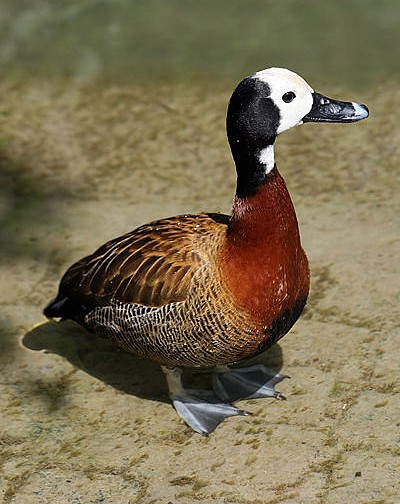Lessico
Dendrocygninae
Scientific
classification
Kingdom: Animalia
Phylum: Chordata
Class: Aves
Order: Anseriformes
Family: Anatidae
Subfamily: Dendrocygninae Reichenbach, 1853
Genus: Dendrocygna Swainson, 1837
Species
Dendrocygna arborea
Dendrocygna arcuata
Dendrocygna autumnalis
Dendrocygna bicolor
Dendrocygna eytoni
Dendrocygna guttata
Dendrocygna javanica
Dendrocygna viduata
Dendrocygninae is a subfamily of the duck, goose and swan family of birds, Anatidae. In other taxonomical approaches, they are either considered a separate family Dendrocygnidae, or a tribe Dendrocygnini in the goose subfamily Anserinae (e.g. Terres & NAS, 1991).
It contains only one genus, Dendrocygna, containing eight living species, and one known from hitherto undescribed subfossils from Aitutaki, Cook Islands (Steadman, 2006). These species are the whistling ducks and they have a worldwide distribution through the tropics and subtropics. These ducks have, as their name implies, distinctive whistling calls.
The whistling ducks have long legs and necks, and are very gregarious, flying to and from night-time roosts in large flocks. Both sexes have the same plumage, and all have a hunched appearance and black underwings in flight.
Dendrocygna
arborea
Black-billed Whistling Duck
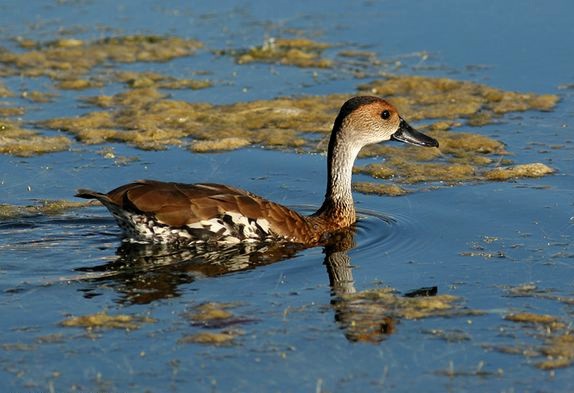
The Black-billed Whistling Duck, Dendrocygna arborea, is a whistling duck which breeds in the West Indies. Alternative names are West Indian Whistling Duck and Cuban Whistling Duck.
The Black-billed Whistling Duck is widely scattered throughout the West Indies including a large breeding population in the Bahamas, and smaller numbers in Cuba, the Cayman Islands, Antigua and Barbuda, and Jamaica. It is largely sedentary, apart from local movements which can be 100 km or more. Nests have been reported in tree cavities, on branches, in clumps of bromeliads, and on the ground under thatch palms and other dense bushes. The usual clutch size is 10-16 eggs. It habitually perches in trees, which gives rise to its specific name.
The birds are mostly nocturnal and secretive, inhabiting wooded swamps and mangroves, where this duck roosts and feeds on plant food including the fruit of the Royal Palm.
The Black-billed Whistling Duck is the largest (48-58 cm) and darkest of its genus. It has a long black bill, long head and longish legs. It has a pale foreneck and light brown face. The crown, back, breast and wings are dark brown to black, and the rest of the underparts are white with heavy black markings. All plumages are similar, except that juveniles are duller and have a less contrasted belly pattern.
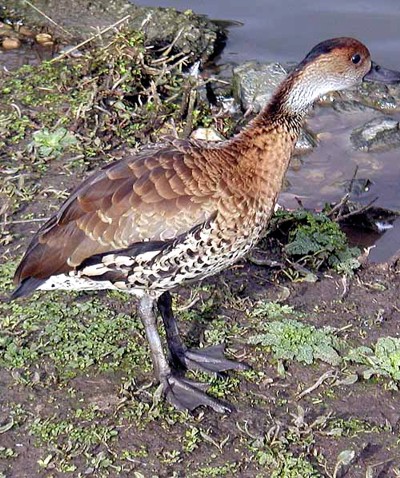
The Black-billed Whistling Duck has suffered extensive hunting for its eggs and for sport. Wetlands are a very limited habitat in the Caribbean, with continuing conversion for development and agriculture. More than 50% of remaining wetlands are seriously degraded by the cutting of mangroves and swamp-forest, pollution (especially over-use of pesticides1) and natural catastrophes such as droughts and hurricanes. Predation is inadequately documented but may be a factor.
CITES Appendix II. CMS Appendix II. It is legally protected throughout much of its range, but law enforcement is inadequate. N. L. Staus (1997) The West Indian Whistling Duck Working Group initiated a conservation programme in 1997. L. G. Sorenson (1997) There are several protected areas in the region but, in general, suitable habitat, especially wetlands, is under-represented. N. L. Staus (1997)
Conduct extensive surveys to assess numbers and distribution; assist local authorities in establishing a long-term monitoring programme; conserve key sites; enforce legal protection; initiate public education and awareness programmes. Staus (1997)
Dendrocygna
arcuata
Wandering Whistling Duck
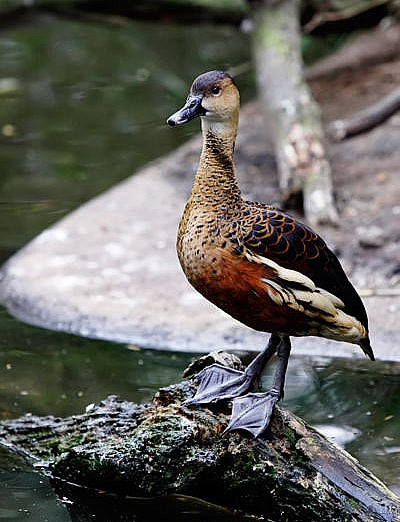
Formally named Tree Ducks, the Wandering Whistling Duck have their new name because of their loud whistling calls and the whistling noise their wings make during flight. They have long necks and legs and look like a cross between a goose and a duck. They have a strong head and neck with a darker crown and hindneck. The breast contains black spotting and the feathers are mostly dark brown.
They range in size from 54-60 cm in height and weigh on average 750 grams. They mainly feed on grasses, waterlillies, water plants and occasionally insects and aquatic vertebrae.
The
Wandering Whistling Duck lives in deep lagoons, flooded grasslands or dams.
They enjoy the water and rarely leave the shore and swim and dive with ease.
Breeding occurs during the tropical wet season usually between December and
May. During this time six to fifteen eggs are laid in a nest not far from
water and usually in high grass or a sheltered area
Dendrocygna
autumnalis
Black-bellied Whistling Duck
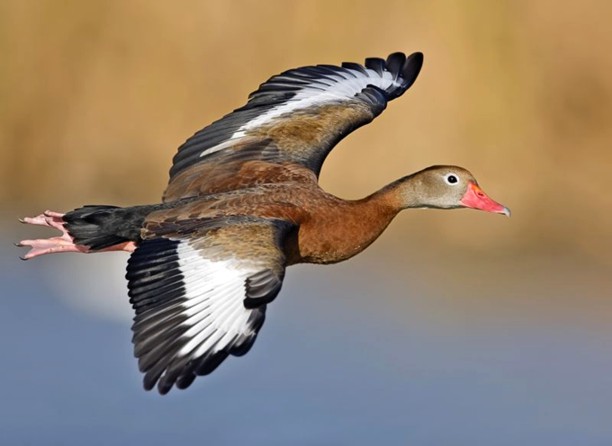
The Black-bellied Whistling Duck (Dendrocygna autumnalis) is a whistling duck that breeds in the southernmost USA and tropical Central and South America. The Black-bellied Whistling Duck is a common but wary species. It is largely resident, apart from local movements. It usually nests in hollow trees. The habitat is quiet freshwater lakes, cultivated land or reservoirs with plentiful vegetation, where this duck feeds mainly at night on seeds and other plant food. It is highly gregarious, forming large flocks when not breeding.
The Black-bellied Whistling Duck is 48-53 cm long. It has a long red bill, long head and longish legs, pale grey head and mostly grey-brown plumage. The belly is black and the large white wing bar is visible in flight.
All plumages are similar, except that juveniles have a grey bill and less contrasted belly. As the name implies, these are noisy birds with a clear whistling waa-chooo call. It is known as 'pijije' in Latin American countries such as Costa Rica, Mexico and Cuba.
Due to its unique appearance, this species is almost unmistakable. With an upright stance, long pink legs, and long neck, adult Black-bellied Whistling-Ducks are unlikely to be confused with any other species within their range. The belly is black, and the back, breast, lower neck, and cap are a rich chestnut brown. The face and upper neck are gray, and they sport a distinct white eye-ring. The extensive white in the wings is obvious in flight.
Black-bellied Whistling-Ducks prefer shallow freshwater ponds, lakes, and marshes. Tree-lined bodies of water are of particular value. The species was formerly known as the Black-bellied Tree Duck; as this name suggests, they are quite fond of perching. Additionally, tree cavities provide nesting sites. This species can also be seen “loafing” in flocks on golf courses and other grassy areas near suitable waterways.
Feeding often occurs nocturnally, but can occur at any hour. Black-bellied Whistling-Ducks ingest a wide variety of plant material, but also consume insects and aquatic invertebrates when available. They often feed on submerged vegetation by wading through shallow water. In Mexico, the Black-bellied Whistling-Duck is known as “pato maizal,” or cornfield duck, as it is commonly seen gleaning recently harvested fields. The ducks have even been documented opening fresh husks of corn and feeding on the kernels within!
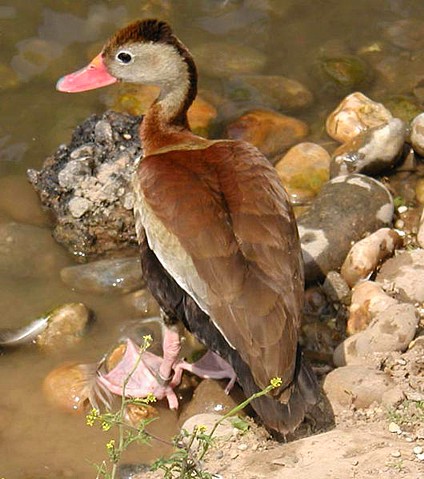
The Black-bellied Whistling-Duck is unique among ducks, in that pairs often stay together for many years, a trait more often associated with geese and swans. Both parents share all tasks associated with the raising of young, from incubation to the rearing of ducklings. The ducks, primarily cavity nesters, prefer the confines of a hollow tree, but will nest on the ground when necessary. They also make use of chimneys, abandoned buildings, or nest boxes, the latter having been increasingly provided to them over recent decades, especially in southeast Texas and Mexico. Ducklings leap from nest cavities within two days of hatching, can feed themselves immediately, and stay with the parents for up to eight weeks.
The Black-bellied Whistling-Duck is mainly non-migratory. Birds in the extreme northern portions of their range (Arizona, Louisiana, and parts of Texas) move south in winter. At the heart of their range, there is a tendency to travel in flocks over the winter months, though this behavior is not necessarily migratory.
The Black-bellied Whistling-Duck is an unusual species among North American waterfowl. With its long legs, peculiar appearance, and odd habits, it was described by one early American ornithologist as “most un-duck-like.” Its numbers are increasing in North America.
The Black-bellied Whistling-Duck is a common bird on the Mexico coast. To the south, its range extends throughout Central America, and across much of South America. In the United States, it can be found year-round in parts of southeast Texas, and seasonally in southeast Arizona, and Louisiana’s Gulf Coast. It is a rare breeder in such disparate locations as Florida, Arkansas, and South Carolina. A legend for the range map to the right can be found here.
Black-bellied Whistling-Duck populations are currently stable or increasing. The species expanded its range significantly in the latter half of the 20th century, and has benefited in recent years from the placement of nest boxes across key portions of its range. Breeding Bird Survey and Christmas Bird Count data both confirm that populations of this species have increased significantly over the past 30 years.
The existence of healthy coastal wetlands greatly benefits Black-bellied Whistling-Ducks. In past years, over-hunting was a serious concern, largely due to the species’ relatively docile nature. Current populations, however, seem to be secure in number.
Dendrocygna
bicolor
Fulvous Whistling Duck
The
Fulvous Whistling Duck, Dendrocygna bicolor, is a whistling duck which
breeds across the world's tropical regions in much of Central and South
America, sub-Saharan Africa, the Indian subcontinent, and the United States
Gulf Coast.
Fulvous Whistling Duck is a common but wary species. It is largely resident,
apart from local movements, but vagrancy has occurred to southern Europe. It
nests on a stick platform in reeds, laying 8-12 eggs, but hollow trees or old
bird nests are occasionally used for nesting.
The habitat is still freshwater lakes, ricefields or reservoirs with plentiful vegetation, where this duck feeds mainly at night on seeds and other plant food.
Fulvous Whistling Duck is 48-53cm long. It has a long grey bill, long head and longish legs, buff head and underparts, the latter reddish-tinged on the flanks, a dark crown, and dark grey back and wings. The tail and wing patches are chestnut, and there is a white crescent on the uppertail which is visible in flight. All plumages are similar, except that juveniles have less contrasted flank and tail colouration.
This species is gregarious, and at favoured sites substantial flocks can form. As the name implies, these are noisy birds with a clear whistling kee-wee-ooo call.
The Fulvous Whistling Duck is one of the species to which the Agreement on the Conservation of African-Eurasian Migratory Waterbirds (AEWA) applies.
Dendrocygna
eytoni
Plumed Whistling Duck
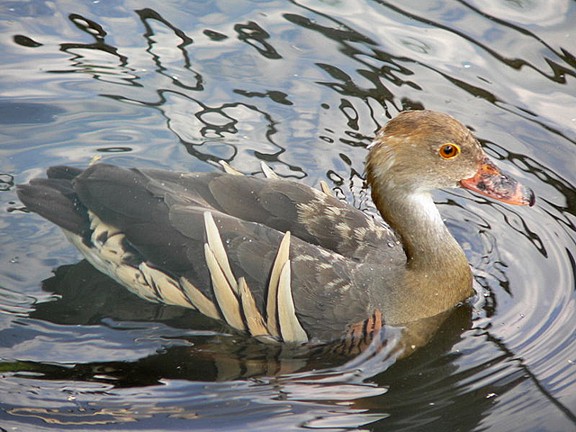
The Plumed Whistling Duck, Dendrocygna eytoni, is a whistling duck which breeds in New Guinea and Australia.
Dendrocygna
guttata
Spotted Whistling Duck
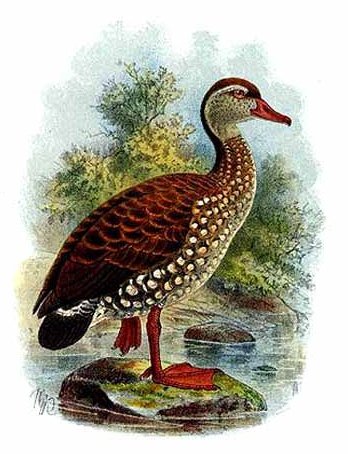
The Spotted Whistling Duck, Dendrocygna guttata, is a member of the duck family Anatidae. This species has a large range, with an estimated global Extent of Occurrence of 100,000-1,000,000 km². It has a large global population estimated to be 10,000-25,000 individuals (Wetlands International 2002). Global population trends have not been quantified, but the species is not believed to approach the thresholds for the population decline criterion of the IUCN Red List (i.e. declining more than 30% in ten years or three generations). For these reasons, the species is evaluated as Least Concern.
Dendrocygna
javanica
Lesser Whistling Duck
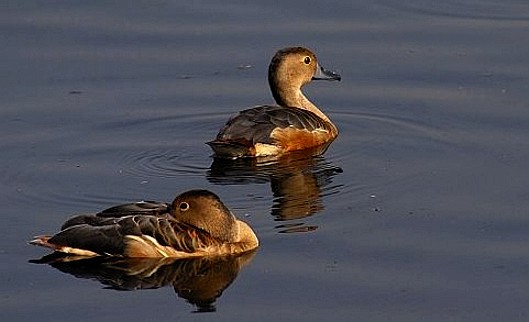
The Lesser Whistling Duck, Dendrocygna javanica, also known as Indian Whistling Duck, is a small whistling duck which breeds in South Asia and southeast Asia. It may also be called the Lesser Whistling Teal (based on an older classification), or the Tree Duck.
This is a largely resident species distributed unevenly from the Pakistan lower river valleys eastwards across most of peninsular India, Nepal terai, Sri Lanka, Bangladesh, Myanmar, Thailand, Malaysia, Indonesia, south China, to Vietnam. It is largely resident, apart from local movements (often induced by drought or floods), but Chinese birds winter further south.
Covering between 1 to 10 million km², it is estimated to have a global population of between two and twenty million individuals.
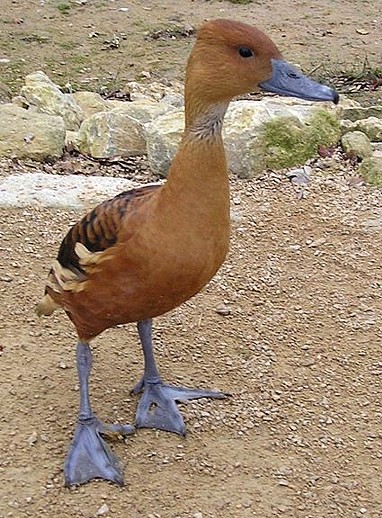
Habitat: still freshwater lakes, with plentiful vegetation, where this duck feeds on seeds and other vegetation. Occasionally seeks refuge in the ocean just outside the surf area. May be seen often perching on trees near water bodies, giving rise to the alternate name Tree Duck.
This
species has a long grey bill, long head and longish legs. It has a buff head,
neck and underparts, and a darker crown. The back and wings are darkish grey,
and there are chestnut patches on the wings and tail. All plumages are similar.
This species is gregarious, and at favoured sites, such as Carambolin Lake in
India, the flocks of a thousand or more birds arriving at dawn are an
impressive sight. The call is a wheezy, whistling "seasick, seasick",
call, uttered in flight. Roosts can be quite noisy.
It nests in tree holes, old nests of other birds, or on a stick platform near the ground, and lays 6-12 eggs.
Dendrocygna
viduata
Dendrocigna facciabianca
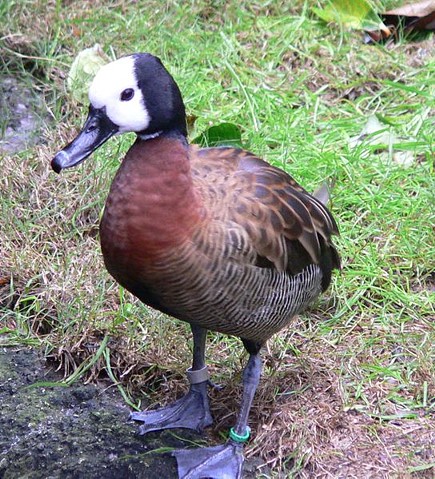
La Dendrocigna facciabianca (Dendrocygna viduata) fa parte, con alcune affini, del gruppo delle anatre con abitudini arboricole, le quali esteriormente sono distinte dalle forme alte e snelle, dal collo di media lunghezza, dalla testa ben conformata, dal becco sottile; hanno inoltre zampe alte, ali ottuse e coda corta, rigida e tondeggiante.
Lunga circa 45 cm, con coda di 6 e ali di poco superiori ai 20, la nostra specie si presenta colorata di bianco sulla faccia e sulla gola, con la fronte e le guance bruno-rossicce, l'occipite, i lati ed il retro del collo neri, l'alto del petto e il basso del collo bruno-rossi, i lati del petto e il dorso di color giallastro-fulvo con ondulazioni trasversali e macchie più scure. La parte inferiore del dorso, il centro della coda e tutte le parti inferiori a cominciare dal petto sono tinti di nero, mentre le remiganti secondarie sono bruno-olivastre e le primarie, assieme con le timoniere, nero-brunicce. L'occhio è bruno-rosso, il becco nero e segnato da un nastro grigio-cenere prima del bitorzolo terminale, e il piede è plumbeo.
L'anatra vedova vive in moltitudini sterminate nei luoghi paludosi delle steppe dell'America meridionale, e si incontra in gran numero nelle analoghe località dell'ovest e del sud del Continente africano. Si distingue dalle affini per il camminare facile, che richiama alla mente quello delle oche, e per il volo che, al contrario, è piuttosto faticoso e pesante.
Dendrocygna
viduata
White-faced Whistling Duck
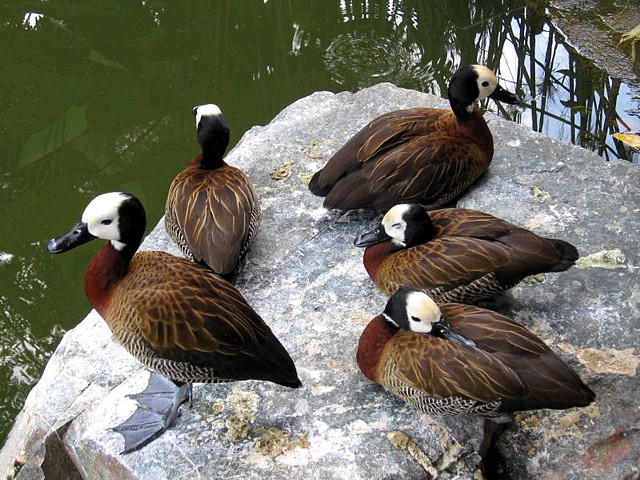
The White-faced Whistling Duck, Dendrocygna viduata, is a whistling duck which breeds in sub-Saharan Africa and much of South America. This is an abundant species. It is largely resident, apart from local movements which can be 100km or more. It nests on a stick platform near the ground, and lays 8-12 eggs. Trees are occasionally used for nesting.
The habitat is still freshwater lakes or reservoirs, with plentiful vegetation, where this duck feeds on seeds and other plant food. This species has a long grey bill, long head and longish legs. It has a white face and crown, and black rear head. The back and wings are dark brown to black, and the underparts are black, although the flanks have fine white barring. The neck is chestnut. All plumages are similar, except that juveniles have a much less contrasted head pattern.
This species is gregarious, and at favoured sites, the flocks of a thousand or more birds arriving at dawn are an impressive sight. As the name implies, these are noisy birds with a clear three-note whistling call. The White-faced Whistling Duck is one of the species to which the Agreement on the Conservation of African-Eurasian Migratory Waterbirds (AEWA) applies.
